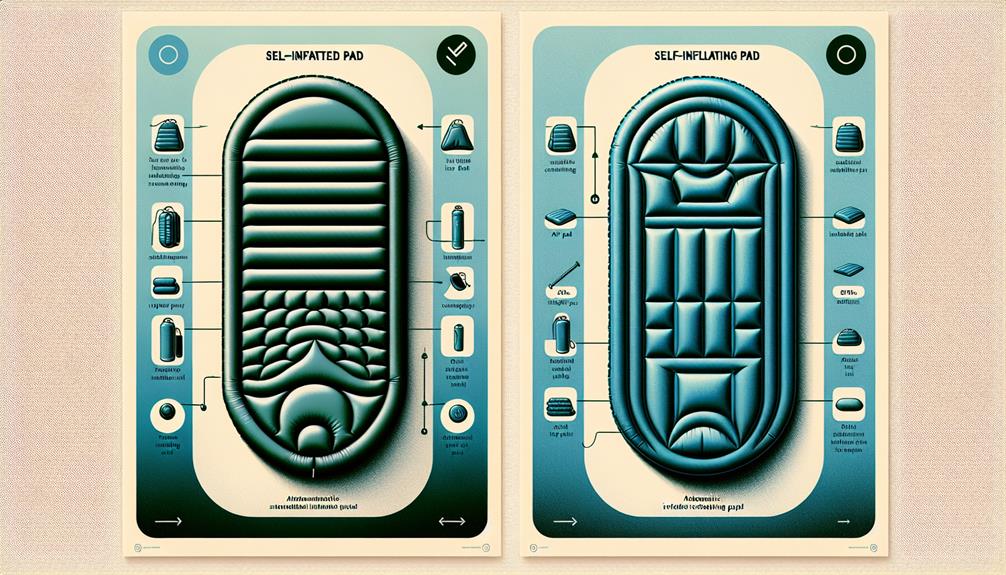When it comes to choosing the right sleeping pad for your outdoor adventures, the decision between an air pad and a self-inflating pad can be a crucial one. Both options have their unique features and advantages, from inflation methods to comfort levels and portability.
Understanding the key differences between the two can significantly impact your camping experience. Let's explore the nuances between air pads and self-inflating pads to help you make an informed decision on which one might be the best fit for your next outdoor escapade.
Key Takeaways
- Air pads require manual inflation, while self-inflating pads inflate automatically for convenience.
- Self-inflating pads offer better insulation and support due to their foam core construction.
- Air pads are lighter and more portable, ideal for backpacking and minimal packing.
- Durability favors self-inflating pads over air pads, which are more susceptible to punctures.
Inflation Method
Typically, the inflation methods for air pads and self-inflating pads differ significantly in terms of convenience and efficiency. Air pads usually require manual inflation, either by blowing into a valve or by using a pump. This manual process can be time-consuming and tiring, especially after a long day of hiking or camping.
On the other hand, self-inflating pads feature an automatic inflation mechanism that eliminates the need for manual intervention. By simply opening a valve, the pad automatically draws in air and expands to its full size, providing a hassle-free setup experience.
In terms of efficiency, self-inflating pads have the upper hand. The automatic inflation process of self-inflating pads is not only more convenient but also faster compared to manually inflating air pads. This efficiency can be crucial when setting up camp in challenging weather conditions or when time is of the essence. While air pads may offer a more customizable firmness level through manual inflation, the ease and speed of self-inflating pads make them a popular choice for many outdoor enthusiasts.
Insulation and Thickness
When considering the insulation and thickness of air pads and self-inflating pads for outdoor sleeping systems, the design variations between the two types play a significant role in providing comfort and warmth during camping or hiking expeditions.
Insulation effectiveness is a key factor in determining how well a sleeping pad can retain body heat and shield the sleeper from the cold ground. Self-inflating pads generally offer better insulation properties due to their foam core, which traps heat effectively. On the other hand, air pads, while they can provide sufficient insulation, may not be as effective in extremely cold conditions.
Thickness also plays a crucial role in the comfort and support provided by sleeping pads. Thicker pads offer more cushioning and are better at conforming to the body's contours, enhancing overall comfort during sleep. However, thicker pads often result in a larger packed size, which can be a consideration for backpackers and campers looking to minimize the weight and bulk of their gear.
Balancing insulation effectiveness with packing size is essential when choosing between air pads and self-inflating pads for outdoor adventures.
Weight and Portability
Considering weight and portability is crucial when comparing air pads and self-inflating pads for outdoor sleeping systems. Air pads are typically lighter and more compact than self-inflating pads, making them a preferred choice for backpackers and hikers looking to minimize weight and save space. The weight of an air pad can vary depending on the material used, with ultralight options weighing as little as 1 pound, while heavier-duty models can weigh around 2-3 pounds. In comparison, self-inflating pads tend to be bulkier and heavier due to their internal foam insulation, making them more suitable for car camping or situations where weight and size are less of a concern.
When it comes to portability, air pads can be easily compressed and rolled up into a compact size, fitting snugly into a backpack without taking up much space. On the other hand, self-inflating pads are bulkier and may require more effort to roll up and pack away. In terms of material comparison, air pads are often made of lightweight materials such as nylon or polyester, while self-inflating pads typically feature a combination of foam insulation and durable exterior materials like polyester or polyurethane. Size comparison reveals that air pads can be much smaller when packed, providing a significant advantage in terms of portability.
Comfort and Support
In evaluating outdoor sleeping systems, the aspect of comfort and support becomes a pivotal consideration when comparing air pads and self-inflating pads. When it comes to comfort and support, both types of sleeping pads offer unique features that cater to different preferences and needs:
- Pressure Points: Air pads typically provide customizable firmness levels, allowing users to adjust the pressure to alleviate pressure points and ensure a comfortable sleeping surface.
- Body Contouring: Self-inflating pads are known for their ability to conform to the body's contours, providing excellent support and reducing discomfort during sleep.
- Temperature Regulation: Some air pads come with built-in insulation to regulate temperature, keeping users warm in cold conditions.
- Firmness Levels: Self-inflating pads offer consistent firmness throughout the night, ensuring a stable and supportive surface for restful sleep.
- User Preference: The choice between air pads and self-inflating pads ultimately depends on individual preferences for firmness, body contouring, and temperature regulation.
Durability and Maintenance
For outdoor enthusiasts seeking reliable sleeping gear, assessing the durability and maintenance requirements of air pads and self-inflating pads is essential. Durability is a key factor to consider when choosing between the two types of sleeping pads. Air pads are generally more prone to punctures and tears compared to self-inflating pads, which are usually made of thicker, more durable materials. This can impact the longevity of the sleeping pad and may require more frequent repairs or replacements for air pads.
In terms of maintenance, both air pads and self-inflating pads require cleaning and proper storage to ensure their longevity. Cleaning typically involves wiping down the surface with a damp cloth and mild soap to remove dirt and debris. Proper storage includes making sure the pad is completely dry before packing it away to prevent mold and mildew growth. Additionally, storing the pads in a cool, dry place away from direct sunlight can help maintain their quality over time. Regular maintenance routines can significantly extend the lifespan of both types of sleeping pads.
Frequently Asked Questions
Can Air Pads and Self Inflating Pads Be Used for Both Camping and Backpacking Trips?
Air pads and self-inflating pads are versatile choices for both camping and backpacking trips. Their weight difference and insulation levels vary, with air pads typically lighter but offering less insulation compared to self-inflating pads.
Inflation time is shorter for self-inflating pads, while air pads might require manual inflation. Self-inflating pads tend to be more durable due to their construction. Consider these factors when selecting the best option for your outdoor adventures.
Are There Any Specific Cleaning Instructions for Air Pads and Self Inflating Pads?
Cleaning tips and maintenance are crucial for ensuring the longevity and durability of air pads and self-inflating pads.
To clean these pads, use a mild detergent and water solution, then rinse thoroughly and air dry. Avoid harsh chemicals and excessive scrubbing to prevent damage.
Regular maintenance such as checking for leaks and storing them properly can extend the lifespan of your pads, making them ready for your next outdoor adventure.
How Do Air Pads and Self Inflating Pads Perform in Different Weather Conditions?
When comparing air pads and self-inflating pads' performance in various weather conditions, factors such as insulation effectiveness, durability, comfort level, and weight restrictions play crucial roles.
Air pads may offer better insulation in colder weather due to their ability to trap air for warmth, while self-inflating pads tend to provide consistent comfort levels across different temperatures.
Durability varies based on material quality. Consider these aspects when selecting a pad for specific weather conditions.
Can Air Pads and Self Inflating Pads Be Used on Different Types of Terrain?
When considering the suitability of air pads and self-inflating pads for different terrains, factors such as inflation methods and portability come into play.
Air pads, requiring manual inflation, are generally lighter and more compact, making them suitable for backpacking on various terrains.
Self-inflating pads, though heavier, offer superior comfort and durability, making them ideal for car camping on less rugged terrains.
Balancing these features ensures optimal performance based on terrain specifics.
Are There Any Specific Storage Recommendations for Air Pads and Self Inflating Pads When Not in Use?
Proper maintenance and storage are crucial for ensuring the longevity of both air pads and self-inflating pads.
To prevent damage, it is recommended to store them in a clean, dry place away from direct sunlight and extreme temperatures. Rolling rather than folding the pads can also help maintain their integrity.
Regularly inspecting for any signs of wear and tear and following manufacturer guidelines for care and storage can further extend the lifespan of these camping essentials.
Conclusion
In conclusion, the difference between an air pad and a self-inflating pad lies in their inflation method, insulation and thickness, weight and portability, comfort and support, as well as durability and maintenance.
For example, a hiker may choose an air pad for its lightweight and compact design, while a camper may prefer a self-inflating pad for its convenience and insulation properties.
Ultimately, the choice between the two depends on individual needs and preferences.

